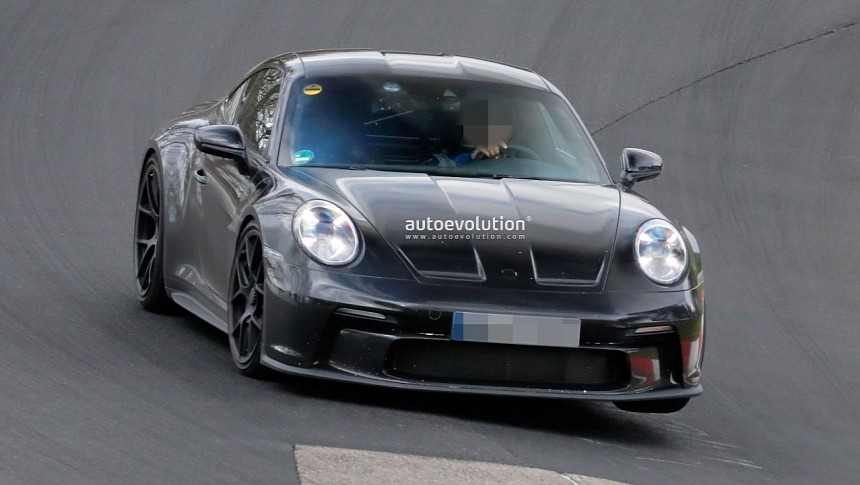Porsche sells more Cayennes and Macans than 911s, and that's a well-known fact. Purists often criticize the Zuffenhausen-based automaker for betraying them by selling utility vehicles to the detriment of sports cars, but purists fail to understand that the 911 wouldn't have so many variants had those SUVs, the Panamera, and Taycan not been immensely popular with customers.
Porsche delivered 95,604 units of the Cayenne and 86,724 units of the Macan last year. The Neunelfer ended last year in third place, boasting 40,410 deliveries compared to 34,142 for the Panamera, 34,801 for the Taycan, and a meager 18,203 units for the 718 series.
As highlighted earlier, the commercial success of the Cayenne and Macan had a positive effect on the 911. One could also make a case for the Neunelfer surviving without the fat profits netted by the aforementioned sport utility vehicles. But alas, that isn't actually the case, given that Porsche once considered discontinuing the 911 in favor of the 928. Back in the late 1990s, the Cayenne was developed with the sole purpose of propping up the company's financial situation by appealing to a tremendously larger pool of customers.
My point is that we shouldn't blame Porsche for its mainstream vehicles. At most, one can consider them a necessary evil. Even the most die-hard 911 loyalists are much obliged to bury the hatchet when you present them with something in the ballpark of a GT3 RS. Speaking of which, the naturally-aspirated engine of the GT3 range is coming to a new variant with an iconic name.
Recently spied cornering on three wheels at the Green Hell in Germany, the 911 ST is named after a racing-oriented Neunelfer produced in small numbers. Tipping the scales at less than a metric ton, the original ended production in 1971. A little over 30 units were completed with 2.2- and 2.5-liter engines. The great-grandfather of the modern-day 911 ST also saw plenty of success on the track, including at the 1000 km Nurburgring, Daytona 6 Hours, and Sebring 12 Hours.
The latest entry in the Heritage range of models will reportedly premiere in the coming weeks. Being a Heritage model, one can expect a limited production run and a pretty high sticker price. Based on the center-lock wheels, every 911 enthusiast is aware that the upcoming ST means business. Carbon fiber for the roof and other panels also adds to the production costs of the ST over a lesser Neunelfer like – for example – the Carrera GTS.
Gifted with a small lip spoiler on the electrically retractable rear spoiler, massive vents behind the front wheel arches, and a camouflaged Heritage badge at the left of the third brake light, the 911 ST is rumored with the same output figures as the 911 GT3 RS. Hearsay suggests the possibility of a manual transmission, although the GT3 RS from the 992 generation is a PDK-only affair. Even if Porsche were to use the slightly less powerful and less torquey GT3 engine, that would be more than enough in combination with three pedals.
As highlighted earlier, the commercial success of the Cayenne and Macan had a positive effect on the 911. One could also make a case for the Neunelfer surviving without the fat profits netted by the aforementioned sport utility vehicles. But alas, that isn't actually the case, given that Porsche once considered discontinuing the 911 in favor of the 928. Back in the late 1990s, the Cayenne was developed with the sole purpose of propping up the company's financial situation by appealing to a tremendously larger pool of customers.
My point is that we shouldn't blame Porsche for its mainstream vehicles. At most, one can consider them a necessary evil. Even the most die-hard 911 loyalists are much obliged to bury the hatchet when you present them with something in the ballpark of a GT3 RS. Speaking of which, the naturally-aspirated engine of the GT3 range is coming to a new variant with an iconic name.
Recently spied cornering on three wheels at the Green Hell in Germany, the 911 ST is named after a racing-oriented Neunelfer produced in small numbers. Tipping the scales at less than a metric ton, the original ended production in 1971. A little over 30 units were completed with 2.2- and 2.5-liter engines. The great-grandfather of the modern-day 911 ST also saw plenty of success on the track, including at the 1000 km Nurburgring, Daytona 6 Hours, and Sebring 12 Hours.
The latest entry in the Heritage range of models will reportedly premiere in the coming weeks. Being a Heritage model, one can expect a limited production run and a pretty high sticker price. Based on the center-lock wheels, every 911 enthusiast is aware that the upcoming ST means business. Carbon fiber for the roof and other panels also adds to the production costs of the ST over a lesser Neunelfer like – for example – the Carrera GTS.
Gifted with a small lip spoiler on the electrically retractable rear spoiler, massive vents behind the front wheel arches, and a camouflaged Heritage badge at the left of the third brake light, the 911 ST is rumored with the same output figures as the 911 GT3 RS. Hearsay suggests the possibility of a manual transmission, although the GT3 RS from the 992 generation is a PDK-only affair. Even if Porsche were to use the slightly less powerful and less torquey GT3 engine, that would be more than enough in combination with three pedals.


















